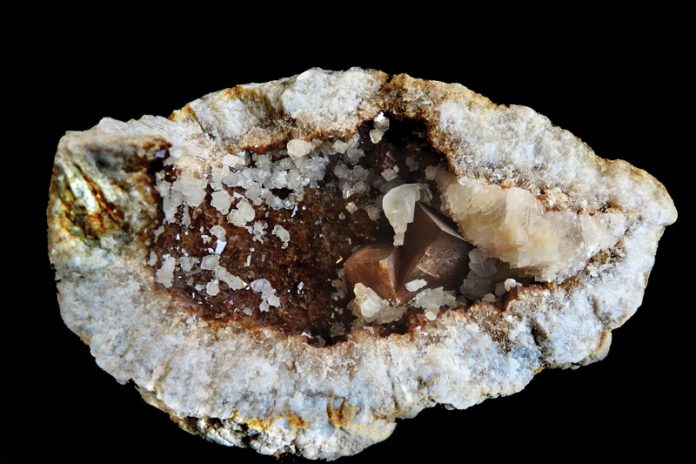
Geodes are popular with rockhounds since there’s always a surprise inside. Who can resist that? The most famous geodes come from Keokuk, Iowa. Find out more about how to find these geodes and what may be waiting inside them.
What is a Geode & Where are Geodes Found?
Simply put, a geode is a rounded rock with a hollow inside that’s lined with crystals, minerals or both. They are found in greatest abundance in a region extending 70 miles in all directions from Keokuk, Iowa.
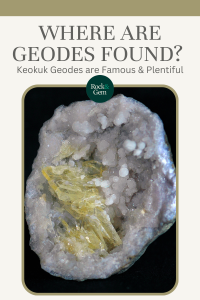
Keokuk geodes are mostly collected in the strata of the lower Warsaw Formation and in the creeks and rivers that erode material from this formation. The lower Warsaw Formation is roughly 340 million years old and contains shales, limestones and dolomites.
How Were Keokuk Geodes Formed?
The question of how Keokuk geodes were formed has haunted geologists and may still not be completely answered. Two ideas lead the way. One is that they formed because of the transformation of anhydrite nodules abundant on the ancient shallow sea floor. The second is that the remains of dead ancient ocean invertebrates provided the hollow sites necessary for geode formation.
Where are Geodes Found and How to Collect Them
No matter your collecting chops, a must-visit is the annual Geode Fest sponsored by the Keokuk Area Convention & Tourism Bureau.
At Geode Fest, you have the opportunity to go on six guided hunts over three days. Some of these sites are not available to collectors except during Geode Fest. At the Geode Fest home base, vendors have a wide array of geodes and related items for sale. You can also have your geodes opened there.
If Geode Fest isn’t in the cards, a list of pay-to-collect sites can be found on the Bureau’s website.
Minerals Found in Keokuk Geodes
While the abundance of the geodes and available collecting sites play a role in their popularity, the diversity and quality of the minerals they contain is the primary draw. Here is a listing and description of minerals found in Keokuk geodes.
Quartz – Found in all Keokuk geodes in the chalcedony rind, several varieties of quartz (SiO2 ) may be present. The color will be clear, milky white or smoky. Some appear yellow or red because they are coated with the disintegration products of iron-containing minerals. In addition to the chalcedony rind, chalcedony may also coat the cavity interior. In the case of the dewdrop diamond geode, white chalcedony underlies the dipyramidal quartz crystals. Pseudocubic quartz is another form that can be found in Keokuk geodes.
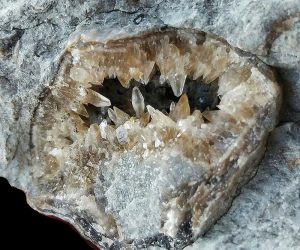
Calcite – The second most common mineral found in Keokuk geodes is calcite (CaCO3 ). Calcite occurs in dozens of modified crystal forms, including the pseudocubic, nailhead, barrel, dogtooth, tabular and pagoda. Colors include clear, white, brown, iridescent brown, pink and black.
Kaolinite – This common clay mineral is found as a snow-white powder. Kaolinite [Al2 Si2 O5 (OH)4 ] contributes to the formation and modification of other secondary minerals in these geodes.
Pyrite – Common as distinct cubes or as yellowish-brown smudges left by disintegrating crystals, pyrite (FeS2 ) cubes vary in color from bright gold (“fools gold”) to brown and may exhibit iridescence.
Marcasite – Pyrite and marcasite (FeS2 ) are polymorphs that have the same chemical formula but exhibit different properties. Marcasite’s color is more variable than pyrite. It can be golden, brassy green, brown or metallic iridescence. The crystal structure can be capillary, tabular, reticulate or cocks comb.
Chalcopyrite -Small chalcopyrite (CuFeS) crystals lack in size but make up in color. The brilliant colors of red, purple, blue and green may be because of an association with other minerals such as malachite.
Aragonite -A polymorph with calcite, aragonite (CaCO3 ) forms star-like clusters of needles that are white to clear.
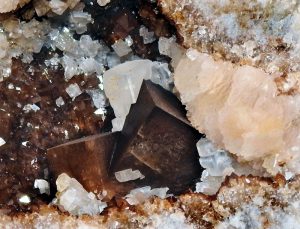
Dolomite – Frequently perched on other crystals in Keokuk geodes, iron-rich dolomite [Ca(MgFe)(CO3 )2 ] forms clusters of small rust-red saddle-shaped crystals.
Sphalerite -Large, beautiful crystals of sphalerite (ZnS) are black with a lustrous surface. The crystals may inhabit the entire central portion of the geode cavity, which sometimes obscures the crystal faces.
Barite -In Keokuk geodes, barite (BaSO4 ) crystals can vary from yellow, blue or white with different levels of transparency. The forms can be tabular, long rods or rosettes.
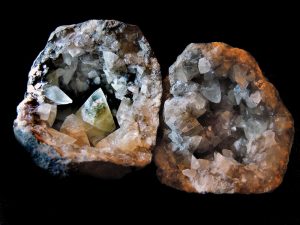
Selenite – The crystal form of gypsum, selenite (CaSO4 •2H2 O) occurs as long slender, transparent rods.
Goethite – Small, shiny black, and capillary in form with doubly terminated crystals, goethite (HFeO2 ) crystals are common. Disintegrated goethite is responsible for some yellow staining on other minerals. Goethite forms pseudomorphs after pyrite, marcasite and dolomite. A pseudomorph is where one mineral replaces another without changing the original crystal form.
Pyrolusite – Appearing as black staining on other minerals, pyrolusite (MnO2 ) may form dendritic growths on calcite and quartz.
Hematite – In Keokuk geodes, hematite (FeO2 ) mostly appears as a deep red powder or a red coating on quartz.
Smithsonite – Rare in Keokuk geodes, smithsonite (ZnCO3 ) appears as botryoidal (grape-like cluster) crystals of a gray, green or light blue color.
Malachite – Uncommon in Keokuk geodes, malachite [Cu2 CO3 (OH)2] presents as small dark green needle clusters. Malachite tends to appear in geodes that also contain chalcopyrite.
Other Substances in Keokuk Geodes
Water and bitumen can also be found in Keokuk geodes. A geode that contains water is called an enhydro. Bitumen is a dense, highly viscous, petroleum-based hydrocarbon that looks like thick oil.
Because of their abundance, diversity, quality of their minerals, and variation in size, Keokuk geodes are considered the royalty of this type of geode.
This story about Keokuk geodes appeared in Rock & Gem magazine. Click here to subscribe. Story by Richard Gross.















